
|
|

February 17, 2006
Towers from the North Country: The Big Trip, 2005
Part II: Duluth-Superior
By SCOTT FYBUSH
Once every year or so, your editor gets together with other similarly radio-crazed folk for an event that's become known as "The Big Trip" - a week (or more) of dawn-to-dusk (and sometimes beyond) traveling in search of interesting new sites to showcase here on Tower Site of the Week, in the Tower Site Calendar, and so on. It's a chance for us to meet people we've only corresponded with via e-mail, and to gather airchecks and legal IDs for our new content partners at www.tophour.net, too. (In our version of a sitcom crossover episode, we're posting the legal IDs from each Friday's Tower Site installment the following Wednesday on Tophour - check it out!)
One of the neat things about these trips is that en route from point A (in this case, our arrival in the Minneapolis-St. Paul metropolis) to point B (International Falls, way up there on the Canadian border, where we were bound for reasons you'll read about next week), we end up stopping in - and learning about - markets that we knew nothing about before setting out.
The second market in our August 2005 Big Trip, following an initial dip into the Minneapolis-St. Paul metropolis, was the two-state market that is Duluth, Minnesota and Superior, Wisconsin, a stopover on Friday night, August 12.
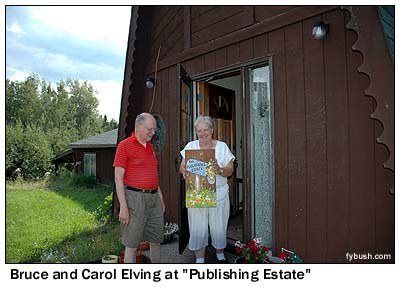 |
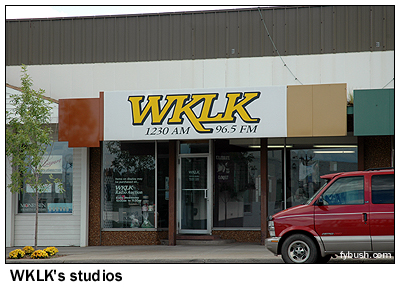
|
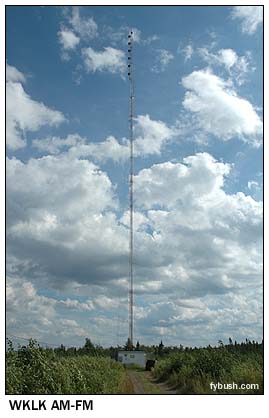 The
one thing we did know about the Duluth market - besides
that we couldn't find an affordable hotel room (it turns out
there was a blues festival in town that weekend) - was that its
western fringes have long been home to one of our colleagues
in the arcane universe of radio station listings.
The
one thing we did know about the Duluth market - besides
that we couldn't find an affordable hotel room (it turns out
there was a blues festival in town that weekend) - was that its
western fringes have long been home to one of our colleagues
in the arcane universe of radio station listings.
Since the early seventies, Bruce Elving has published the "FM Atlas" (now in its twentieth edition), and for the last twenty years or so, that's been accompanied by the monthly "FMedia!" newsletter, all published from "Publishing Estate" in Esko, Minnesota, where our little band of radio folk stopped for a most enjoyable visit with Bruce and Carol. Just like in "Alice's Restaurant," their house used to be a church - but in this case, when they took out all the pews, they filled the space with computers and printing equipment to produce their little media empire.
Just down the road from the Elvings' place, we found the tower that's used by the two stations in nearby Cloquet (rhymes with "Parkay") - WKLK (1230) and WKLK-FM (96.5). (This is the second incarnation of WKLK-FM; the first, which started as a class A facility on 100.9 and was upgraded and moved to 100.5, was sold to Minnesota Public Radio in the eighties and is now WSCN.)
Later that weekend, we'd also get a look at their storefront studio in downtown Cloquet (above right) - but for the moment, we were in a hurry to get to Duluth (actually to Superior, Wisconsin, across the bridge, where we found the least unaffordable hotel room in town), set up the tape decks and the VCRs, and then get out and see the towers.
Being - there's no other way to put this - so far from everything else, Duluth ended up with a bunch of AM signals nice and low on the dial, with reasonable amounts of power from directional arrays that are all clustered south of town and aimed north.
Our first stop is one of the few transmitter sites that's been the subject of a graduate-school thesis: WEBC, which moved to its present site at US 2 and County Highway Z in Parkland, Wisconsin in 1954, when it moved down the dial to its present spot at 560, where its three-tower directional array protects co-channel WIND in Chicago.
Another venerable AM, WDSM (710 Superior), also operates from south of Superior on the Wisconsin side of the border, where its four-tower array sits at the end of Pokegama Road, near route 105, cranking out 10 kilowatts by day and 5 kW after dark.
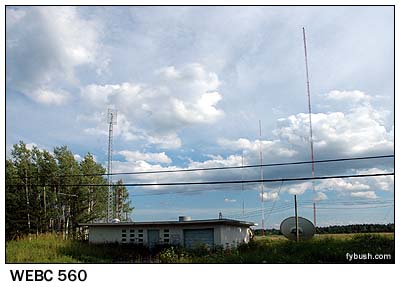 |
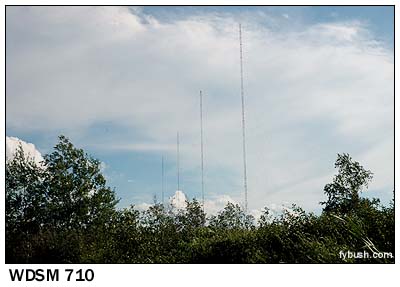
|
Continuing west on 105 to the state line, we cross the St. Louis River to the "New Duluth" neighborhood, where we see the single tower and studio of 10 kW religious daytimer WWJC (850) - and then turning north on Grand Avenue for a few miles, heading back towards downtown, we come to the two-tower site of KDAL (610), where 63rd Avenue dead-ends at Front Street. KDAL runs 5 kilowatts non-directional by day, using both towers with 5 kilowatts at night.
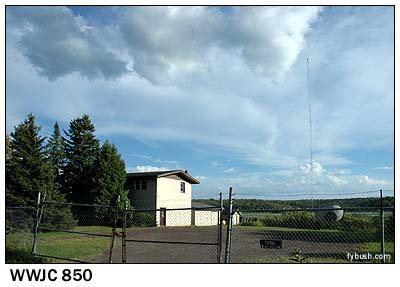 |
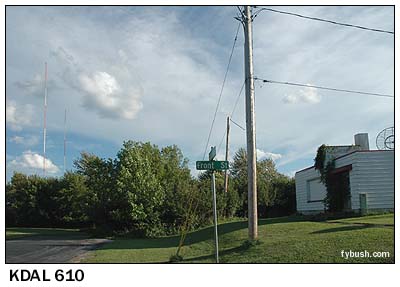
|
We don't have pictures of two other non-directional stations on the Superior side of things: WGEE (970 Superior) and KQDS (1490 Duluth) share a single tower just off the Wisconsin end of the Route 2 bridge over St. Louis Bay.
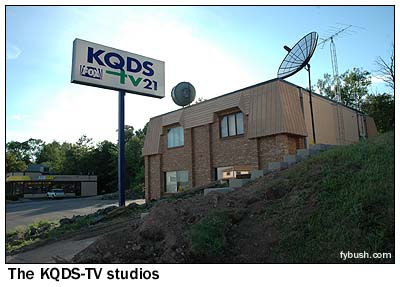 Instead,
with daylight waning fast, we head for the north side of Duluth,
to see the northern terminus of I-35 (we're all road geeks in
this group, too!) and, a few blocks away on London Road (the
old US 61), the studios of Fox affiliate KQDS-TV (Channel 21),
a fairly recent arrival in a TV market that began with a single
UHF station (WFTV, channel 38), then went all-VHF for decades
(CBS affiliate KDAL-TV, later KDLH, channel 3; NBC affiliate
WDSM-TV, later KBJR, channel 6; PBS outlet WDSE, channel 8; and
ABC affiliate WDIO, channel 10) before Fox came to town in the
nineties.
Instead,
with daylight waning fast, we head for the north side of Duluth,
to see the northern terminus of I-35 (we're all road geeks in
this group, too!) and, a few blocks away on London Road (the
old US 61), the studios of Fox affiliate KQDS-TV (Channel 21),
a fairly recent arrival in a TV market that began with a single
UHF station (WFTV, channel 38), then went all-VHF for decades
(CBS affiliate KDAL-TV, later KDLH, channel 3; NBC affiliate
WDSM-TV, later KBJR, channel 6; PBS outlet WDSE, channel 8; and
ABC affiliate WDIO, channel 10) before Fox came to town in the
nineties.
Duluth, as you might glean from the site of the KQDS-TV studios, is a very hilly city, sloping down steeply from the granite hills west of the city to the shores of Lake Superior down below. The city itself is arrayed along a series of terraces parallel to the lakeshore. And up at the top of the hills, all those TV stations - and a whole slew of FMs, too - occupy one of the more scenic tower farms in America, up among the pine trees and lakes overlooking Skyline Drive.
(Speaking of skylines, the view below at right looks down from the TV tower farm towards Minnesota Point, the narrow spit of land that separates Superior Bay from Lake Superior. Duluth's famous Aerial Lift Bridge, just out of frame to the right, connects Minnesota Point to the rest of Duluth, and is said to be the city's top tourist attraction, at least for tourists who aren't also radio geeks.)
In the view below at left, we see the oldest tower in the farm. That little self-supporter at right was the original WEBC-FM (92.3) tower, which rose 550 feet from the hill when it was built in 1947. WEBC-FM didn't last, and after a brief stint as the original site of WFTV (Channel 38), the tower was partially dismantled. (It's now a telco relay site.)
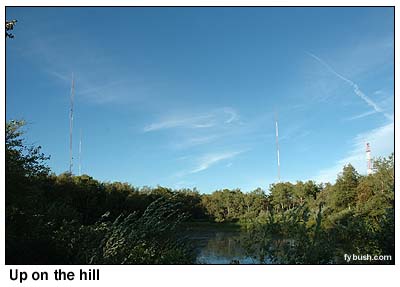 |
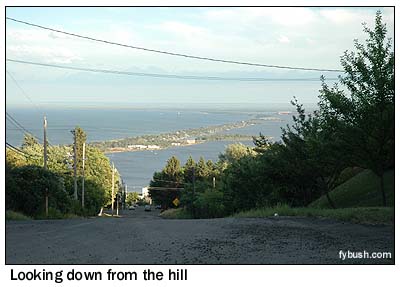
|
I believe the towers at left in that image are public TV WDSE (Channel 8) and the University of Minnesota-Duluth's KUMD (103.3), and I think the one at center right is KBJR (Channel 6), which also is home to FMs KDNI (90.5 Duluth), KUWS (91.3 Superior), WSCN (100.5 Cloquet) and KKCB (105.1 Duluth, the second incarnation of WEBC-FM).
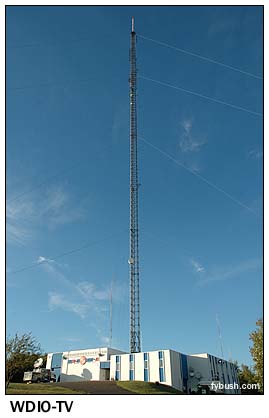
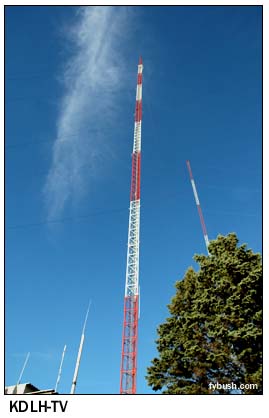 In 1997, KBJR briefly
operated from its transmitter building here, after a fire that
destroyed its downtown studios. Jon Ellis' excellent Upper
Midwest Broadcasting site has some neat framegrabs
of the makeshft operation up here.
In 1997, KBJR briefly
operated from its transmitter building here, after a fire that
destroyed its downtown studios. Jon Ellis' excellent Upper
Midwest Broadcasting site has some neat framegrabs
of the makeshft operation up here.
At the southern end of the farm, on Observation Road, are two of the tallest towers on the hill. KDLH (Channel 3) rises 249 meters above the granite, and right next door, WDIO (Channel 10) towers 255 meters, with its studios right there at the base.
(The "D" is for Duluth and the "IO" looks like 10; the station also has a satellite up in the Iron Range, WIRT 13 in Hibbing, which we'll see later in the trip.)
The WDIO site is also home to three FMs: KDAL-FM (95.7), KLDJ (101.7) and KBMX (107.7).
And with our visit to the TV/FM tower farm complete, we rejoin Bruce and Carol Elving for dinner at a restaurant with a scenic view over the lake and, to the south, over the tower farm as well. It's a pretty good bet that you'll see the sunset shot below in a future Tower Site Calendar. The tall tower at left is KBJR, with the old WEBC-FM tower next to it. KQDS-TV is dead center, with several FMs (KTCO 98.9, WSCD 92.9/KDNW 97.3 and WJRF 89.5/KRBR 102.5) surrounding it. At right, that's WDSE in the foreground, with KDLH to the left and WDIO all the way at the right.
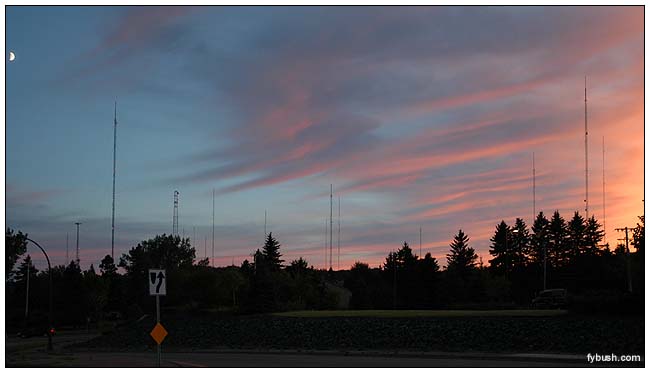
The next morning (Saturday, August 13), we're up early to head out of Duluth to a rendezvous way up north in International Falls, which you'll read about in next week's installment.
Before leaving, though, we have a few more studios to drive by. On Superior Street downtown, there's the former home of KDLH, built here by the old WGN Continental Broadcasting Company (now known as Tribune Broadcasting) back when it owned what was then KDAL radio/TV. Alas, KDLH was no longer a standalone station by the time we visited; it had been purchased by Malara Broadcast Group, which promptly LMA'd the station to Granite (owner of KBJR), which replaced KDLH's full schedule of newscasts with an abbreviated schedule of news produced at KBJR. (That's the Duluth News Tribune just behind the KDLH building, by the way.)
As for KBJR, after it was burned out of its downtown home a few blocks from KDLH, it operated from the WDSE studios while building its current home (below, right) in the Canal Park development, just across I-35 from downtown.
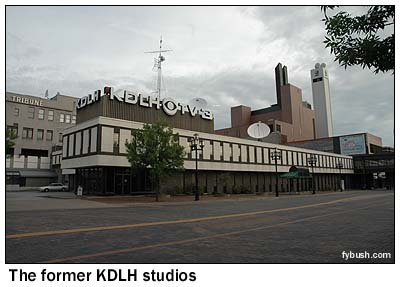
|
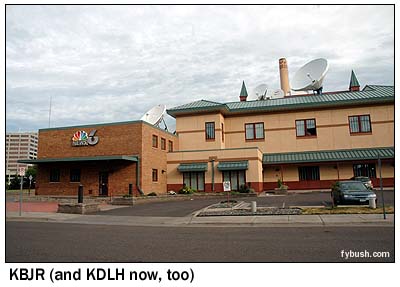
|
And for our final Duluth installments, we head up the hill and out the highway called "Central Entrance," passing the studios of Northwest College's religious duopoly (KDNI 90.5/KDNW 97.3) and Clear Channel's cluster (WEBC, KKBC, KBMX and KLDJ) before heading north on US 53 for the Iron Range and, beyond, our appointment in International Falls.
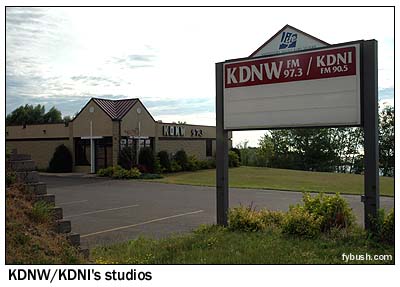
|
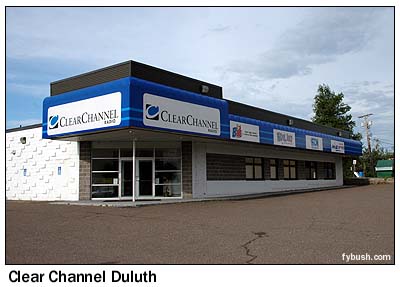
|
What were we after way up in the northernmost reaches of Minnesota? Join us in the next installment for all the excitement - and towers, too. And in the meantime, hear all the IDs from the trip at Tophour.net - the Duluth/Superior IDs will be posted on Wednesday, Feb. 22.
- Previous Site of the Week: The Minnesota/Wisconsin Big Trip, part I: Minneapolis/St. Paul
- Next Week: The Minnesota/Wisconsin Big Trip, Part III: Eveleth, Virginia, International Falls and Fort Frances
- Site of the Week INDEX!
- How can you help support Site of the Week? Click here!
- Submit your suggestions for a future Site of the Week!
